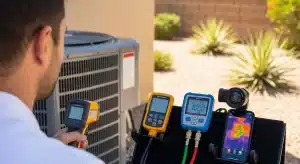
When your air conditioner refuses to stop running, Las Vegas’s scorching heat and soaring energy bills become relentless. Rather than suffering through nightmarish cooling costs, equip yourself with targeted DIY checks and professional-grade diagnostics. In this comprehensive guide, you’ll perform four focused inspections to isolate common faults—then leverage four advanced tools to gather precise data. Should any of our six “red flags” appear, you’ll know exactly when to call our EPA-certified technicians at The Cooling Company for AC repair in Las Vegas.
New to AC troubleshooting? Start with the basics—filter swaps, vent clearing, breaker resets—by reading our AC Troubleshooting blog. Once you’ve covered those, return here to elevate your diagnostics.
1. Verify & Recalibrate Your Thermostat
Even a drift of 3–4°F can keep your system running nonstop, chasing phantom heat loads. Here’s your step-by-step:
- IR Thermometer Comparison: Aim your handheld infrared thermometer (~$25) at the air 4–5 ft away from the thermostat. Compare this reading to the display—accuracy should be within ±2°F. Larger discrepancies indicate calibration errors or sensor failure.
- Mode & Schedule Audit: Check for “Cool,” “Fan On,” “Hold,” or vacation modes. On smart thermostats, verify no remote app override or automation rule is forcing continuous cooling (e.g., “Keep at 75°F at all times”).
- Power-Cycle Reset: Remove batteries or switch off the HVAC breaker for 30 seconds. This clears cached schedules and resets internal sensors.
- Recalibration Procedure: Consult your thermostat’s manual for user-level recalibration steps. Many models allow offset adjustment of up to ±5°F.
- Replacement Consideration: If drift remains after recalibration, replace the unit with a modern Wi-Fi thermostat offering built-in diagnostics, geofencing, and remote ΔT monitoring.
Pro Tip: Position the thermostat away from exterior walls, direct sunlight, and air vents to avoid false temperature readings.
If your system won’t power down despite proper thermostat operation, check electrical safety with “AC Won’t Turn On? Here’s How to Get It Powering Again“.
2. Test the Fan Limit Switch & Blower Control
The fan limit switch protects your heat exchanger and dictates blower operation. When stuck, it can force your blower to run continuously.
- Locate & Safety Shutdown: Power off at the service panel. The fan limit switch sits inside the air-handler cabinet near the blower housing.
- Continuity Testing: With a multimeter set to ohms, test the “fan on” and “fan off” contacts at ambient temperature—both should be open. Heat the switch gently with a hair dryer until you hear a click; the “fan on” contacts should close around 100°F, then reopen around 80°F (“fan off”).
- Bypass Confirmation: Temporarily jumper the “fan on” contacts (power off!) to confirm the switch is the root cause. If the blower stops running when the jumper is removed, replace the switch immediately.
- Switch Replacement: Use a direct OEM replacement. After installation, test five on/off cycles to ensure proper operation before restoring full power.
Why It Matters: A welded fan limit switch not only forces nonstop blower operation but also risks overheating the heat exchanger and triggering safety limit trips.
For airflow troubleshooting prior to advanced fixes, revisit “AC Blowing Hot Air? Fast Vegas-Proof Checks.”
3. Measure Compressor & Blower Current Draw
Abnormal motor amperage is a telltale sign of mechanical drag, electrical faults, or lubrication failures—any of which can lock your system on.
- Startup vs. Steady-State: Clamp a $30–$40 ammeter around one power leg of the compressor and blower. Note the inrush (startup) and steady running amps. Compare these to the nameplate spec ±10% tolerance.
- High Startup Amps: May indicate a failing start capacitor, worn bearings, or excessive refrigerant charge—components that keep the compressor running and prevent shutdown.
- Low Steady-State Amps: Hint at low voltage supply or open motor windings; an underpowered motor may run continuously but never achieve full cycle operation.
- Data Logging: Track readings over multiple cycles and times of day. Intermittent elevated amps during peak desert heat can point to seasonal refrigerant volume issues.
Snapshot Example: A 15-year-old blower motor logged steady-state amps 25% above spec. After bearing lubrication and capacitor replacement, current draw normalized and the system began regular cycling.
Document your measurements and flag any percentage deviations above 10%—these require professional motor or electrical service.
4. Inspect Control Relays & Contactor Operation
Stuck contactors or relays can lock power circuits closed indefinitely.
- Auditory Check: Listen for the contactor “pull-in” click at call-for-cooling and “drop-out” click when satisfied. Absence suggests welded contacts.
- Thermal Imaging: Using your IR thermometer or smartphone thermal camera, scan the contactor coil and relay housings. Temperatures above 120°F indicate high coil resistance or partial shorting.
- LED Error Codes: On modern control boards, blinking patterns map to relay or board faults. Cross-reference with the manufacturer’s service manual.
- Heat-Pump Defrost Relay: For heat-pump systems, a stuck defrost relay can freeze the reversing valve in a defrost cycle, causing continuous compressor operation.
Safety Note: Always de-energize control panels before touching or measuring—live voltage can present serious hazards.
5. Advanced Diagnostic #1: IR Thermometer ΔT Profiling
Mapping ΔT across your home reveals hidden zone inefficiencies.
- Multi-Room Mapping: Measure return and supply ΔT at registers in four quadrants of your home (north, south, east, west). Plot results to identify hot spots where ΔT dips below 12°F.
- Validation Post-Fix: After filter swaps, switch changes, or duct sealing, re-measure ΔT to confirm improvements. A 3–5°F rise in ΔT correlates to 10–15% energy savings.
- Long-Term Monitoring: Use a data-logging IR tool or smart thermostat integration to track ΔT trends over cooling seasons—declines of >2°F per year signal emerging coil fouling.
6. Advanced Diagnostic #2: Static Pressure Testing
Hidden duct restrictions often drive compressors to run continuously.
- Probe Placement: Insert hoses into return and supply pressure taps at least 12″ from seams or bends. Zero the manometer before starting.
- Interpretation: Total static pressure = return + supply. Aim for <0.5 in. w.c.; readings >1.0 in. w.c. waste up to 20% of cooling capacity.
- DIY Sealing: Use UL-approved mastic and mesh tape on visible joints, then retest. If high pressure persists, professional aerosol sealing can address hidden trunk leaks.
7. Advanced Diagnostic #3: Thermal-Camera Coil & Relay Mapping
Professional thermography pinpoints component distress before failure.
- Condenser Coil Scan: Uneven thermal bands or cold streaks reveal blocked passages. Hot tubing sections suggest undercharge or slugging.
- Relay & Control Board Imaging: Identify 120°F+ hotspots on contactors, relays, and transformer coils that indicate high resistance or imminent failure.
- Ductwork Audit: In attics or basements, scan metal trunks—cold plumes show leaks, warm spots highlight missing insulation.
8. Advanced Diagnostic #4: Smart-Home Runtime Monitoring
Leverage IoT sensors for continuous performance insight.
- Wi-Fi Thermostat Logs: Track cycle durations and daily runtime—set alerts for runs >15 minutes beyond thermostat calls.
- Condensate-Overflow Sensor: Detect pan backups that often coincide with continuous fan operation due to float-switch trips.
- Vibration Sensing Plugs: Monitor condenser fan on/off cycles, correlate with thermostat calls for closed-loop diagnostics.
9. Six “Red Flags” to Call the Pros
- Thermostat misreads >3°F after recalibration
- Fan limit switch fails to open/close at thresholds
- Motor amperage deviates >±10% of nameplate spec
- Contactors/relays remain hot or stick without clicks
- Static pressure >1.0 in. w.c. despite DIY sealing
- ΔT profiling stays below 12°F in multiple zones
Ignoring these can void warranties, cause compressor burnout, and inflate energy costs. For guidance on vetting trustworthy contractors, see Identifying & Avoiding AC Repair Scams.
10. Why Professional Repair Pays Off
While advanced DIY can extend system life and save energy, licensed HVAC professionals deliver unmatched precision:
- Digital Refrigerant Charging: Scales and leak dyes to exact factory-spec charges.
- OEM Component Replacement: Genuine capacitors, contactors, motors, and compressors to maintain design tolerances.
- Data-Driven Maintenance Plans: Biannual tune-ups sustaining 95% of original SEER rating and extending equipment life by 30%.
- Insured & EPA-Certified Service: Liability coverage and compliance with all refrigerant regulations—your home and warranty stay protected. For details on required certification for handling refrigerants, see EPA Section 608 Technician Certification.
Next Steps
You’ve armed yourself with four DIY checks and four pro-level diagnostics. If you encounter any red flags—or simply want peace of mind—don’t hesitate. Book same-day AC repair in Las Vegas or call us at (702) 567-0707. Our certified technicians will diagnose, repair, and optimize your system so you can enjoy uninterrupted cool comfort all summer long.



